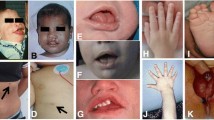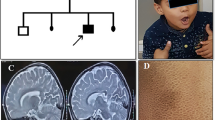Summary
Hunter syndrome is a human X-linked disorder caused by deficiency of the lysosomal exohydrolase iduronate-2-sulphatase (IDS). The consequent accumulation of the mucopolysaccharides dermatan sulphate and heparan sulphate, in the brain and other tissues, often results in death before adulthood. There is, however, a broad spectrum of severity that has been attributed to different mutations of the Hunter syndrome gene. We have used an IDS cDNA clone to localise the IDS gene to Xq28, distal to the fragile X mutation (FRAXA). One-third of Hunter syndrome patients had various deletions or rearrangements of their IDS gene, proving that different mutations are common in this condition. Deletions of the IDS gene can include a conserved locus that is tightly linked to FRAXA, suggesting that deletion of nearby genes may contribute to the variable clinical severity noted in Hunter syndrome. The cDNA clone was also shown to span the X chromosome breakpoint in a female Hunter syndrome patient with an X;autosome translocation.
Similar content being viewed by others
References
Bielicki J, Freeman C, Clements PR, Hopwood JJ (1990) Human liver iduronate-2-sulphatase: purification, characterization and catalytic properties. Biochem J 271:75–86
Hopwood JJ (1982) α-l-Iduronidase, β-d-glucuronidase and 2-sulfo-l-iduronate-2-sulphatase preparation and characterization of radioactive substrates from heparin. Carbohydr Res 69:203–216
Hopwood JJ (1989) Enzymes that degrade heparin and heparan sulphate. In: Lane D, Lindahl U (eds) Heparin: clinical and biological properties, clinical applications. Arnold, London, pp 191–288
Hopwood JJ, Morris CP (1990) The mucopolysaccharidoses: diagnosis, molecular genetics and treatment. Mol Biol Med 7:381–404
Hopwood JJ, Muller V, Harrison JR, Carey WF, Elliott H, Robertson EF, Pollard AC (1982) Enzymatic diagnosis of the mucopolysaccharidoses: experience of 96 cases diagnosed in a 5-year period. Med J Aust 1:257–260
Lim TW, Leder IG, Bach G, Neufeld EF (1974) An assay for iduronate sulfatase (Hunter corrective factor). Carbohydr Res 37:103–109
Mandel JL, Willard HF, Nussbaum RL, Romeo G, Puck JM, Davies KE (1989) Report of the committee on genetic constitution of the X chromosome. (10th International Workshop on Human Gene Mapping) Cytogenet Cell Genet 51:384–437
Mossman J, Blunt S, Stephens R, Jones EE, Pembrey M (1983) Hunter disease in a girl: association with X∶5 chromosomal translocation disrupting the Hunter gene. Arch Dis Child 58:911–915
Nelson PV, Carey WF, Morris CP, Pollard AC (1989) Cystic fibrosis: prenatal diagnosis and carrier detection by DNA analysis. Med J Aust 151:126–131
Neufeld EF, Muenzer J (1989) The mucopolysaccharidoses. In: Scriver CR, Beaudet AL, Sly WS, Valle D (eds) The metabolic basis of inherited disease, 6th edn. McGraw-Hill, New York, pp 1565–1588
Roberts SH, Upadhyaya M, Sarfarazi M, Harper PS (1989) Further evidence localising the gene for Hunter's syndrome to the distal region of the X chromosome long arm. J Med Genet 26:309–313
Robertson DA, Callen DF, Baker EG, Morris CP, Hopwood JJ (1988) Chromosomal localization of the gene for human glucosamine-6-sulphatase to 12q14. Hum Genet 79:175–178
Simmers RN, Smith J, Shannon MF, Wong G, Lopz AF, Baker E, Sutherland GR, Vadas MA (1988) Localization of the human G-CSF gene to region of breakpoint in the translocation typical of acute promyelocytic leukaemia. Hum Genet 78:134–136
Sutherland GR, Hecht F (1985) Fragile sites on human chromosomes. Oxford University Press, New York
Suthers GK, Callen DF, Hyland VJ, Kozman HM, Baker E, Eyre H, Harper PS, Roberts SH, Hors-Cayla MC, Davies KE, Bell MV, Sutherland GR (1989) A new DNA marker tightly linked to the fragile X locus (FRAXA). Science 246:1298–300
Wilson PJ, Morris CP, Anson DS, Occhiodoro T, Bielicki J, Clements PR, Hopwood JJ (1990) Hunter syndrome: isolation of an iduronate-2-sulphatase cDNA clone and analysis of patient DNA. Proc Natl Acad Sci USA 87:8531–8535
Author information
Authors and Affiliations
Rights and permissions
About this article
Cite this article
Wilson, P.J., Suthers, G.K., Callen, D.F. et al. Frequent deletions at Xq28 indicate genetic heterogeneity in Hunter syndrome. Hum Genet 86, 505–508 (1991). https://doi.org/10.1007/BF00194643
Received:
Revised:
Issue Date:
DOI: https://doi.org/10.1007/BF00194643




